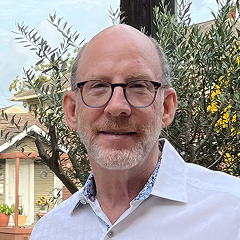Jeffrey has always approached life with a good sense of humor and an unwavering dedication to helping others in his community. As a longtime chiropractor and professor, he’s passionate about connecting with students, encouraging empathy and compassion and reminding them that every patient is more than just a diagnosis.
“I tell my students that you’re not treating a disease, you’re treating a person, trying to live their life. That perspective matters.”
Jeffrey’s story took a personal turn in his early 60s when he began experiencing unexplained tremors and issues with coordination and non-motor signs. At first, he didn’t acknowledge or recognize the signs. Like many people and some doctors unfamiliar with Parkinson’s disease (PD), they couldn’t put it all together.
But after a series of tests and visits with his neurologist, he finally received a diagnosis: Parkinson’s disease. “I went through all the stages of grief. Anger. Denial. I remember thinking, ‘Why me?’” Jeffrey recalls. “But after some time, I got into the mindset of, ‘Put one foot in front of the other and just live.’”
As a self-described perfectionist, Jeffrey noticed how PD started impacting his day-to-day life, particularly his energy and mood. Teaching, which was once a joy for him, became a struggle. He felt he wasn’t himself with his students. That’s when he knew something had to change.
After exploring a few different treatment options, Jeffrey and his doctor decided it was time to try a new approach. In February, with support from his care team to navigate access, he began taking CREXONT® (carbidopa and levodopa) extended-release capsules, 70 mg/280 mg carbidopa/levodopa three times per day. Within weeks, he noticed changes in how he moved around his home, especially his walking and arm swing. “I don’t want people looking at me and seeing someone who’s sick. I don’t want pity. I just want to feel like myself.” While every patient’s journey is unique, for Jeffrey, consistency in care and treatment has been key.

Today, as an avid bowler, he competes several times a week with a group of friends to socialize and hone his skills. And he continues to lean on the love and support of his wife of 35 years, Yvonne. “I’m fortunate to have her by my side. I don’t know if I could do it alone,” he says.
Jeffrey knows that Parkinson’s isn’t something you choose, but how you respond to it is. His story is one of self-awareness, strength, and a desire to keep doing the things that make him feel most like himself. “I found something that helps me feel more like my old self again,” he says. “That matters. I just want to live my life.”
When asked why he wanted to share his story, Jeffrey shared “I would hate to go back and start all over. This works for me, and that means everything.”
Jeffrey’s experience with CREXONT is his own and may not reflect the experience of every patient. For some patients, CREXONT may cause falling asleep during daily activities. Side effects may include nausea and anxiety. Individual results will vary. Talk to your patients to see if CREXONT is right for them. Only an HCP should assess each patient’s condition and advise them on treatment options.




